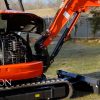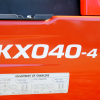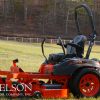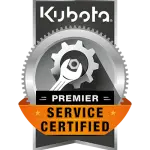If you’re in the market to buy a used tractor, you’re going to want to do more than kick the tires. It’s not always easy to tell if tractor maintenance has been neglected, but there are some tell-tale signs to look out for.
Here’s my walkthrough and a handy used tractor inspection checklist to help you find a reliable, well-maintained tractor.
1. Check the safety features.
- First, check the ROPS. Almost all modern tractors have a roll bar, but some older tractors don’t have them. If you’re looking at a newer model tractor and the ROPS is missing, ask the seller if it was removed – and if he still has it.
- Seat belt – If the tractor has a roll bar it needs a seat belt and you need to wear it… If no roll bar is present there should be no seat belt.
- Safety switches – you’ll find safety switches in different areas of the tractor. Check the clutch pedal, brake pedal, transmission, and PTO. Safety switches don’t allow the engine to start unless the transmission and PTO are not in gear and the brakes are on.
2. Do a visual inspection.
Take a walk around the tractor, looking for dents, rust, and missing paint. If the tractor is in rough shape, it may have been in an accident or simply suffered from neglect. Which means it might not be mechanically sound, either. If it’s missing paint but the sheet metal is in good shape, repainting is not a problem.
Then kick the tires. Hey, I didn’t say we weren’t going to do that.
Check the tires for excessive or uneven wear. Look for depth of tread, damage, and signs of repair, like plugs or patches. Bad tires don’t have to be a deal-breaker, but replacing tractor tires can be pricey. You need to know if you’re going to run into another big expense immediately after shelling out for a used tractor.
3. Check the water pump.
Make sure the engine is not running and then stick your hand right in there and try to wiggle the fan blades to see if it’s nice and stable. Check the belts as well to make sure everything is tight.
4. Check the fluids.
With the engine off and cool, pop open the hood and check all the fluids.
- Take the cap off the radiator. Make sure it has coolant and there’s no oil floating in it.
- Check the engine oil. Use the dipstick to check the level and make sure there’s no water beaded on the stick. The oil should be black unless it has been freshly changed.
- Check the transmission/ hydraulic oil. Hydraulic oil should be almost clear, so you might have to run your finger on the dipstick to feel the level. Have a rag handy to clean your hands when you check fluids.
- Power steering pump. Screw the cap off and check the fluid level. Most modern tractors don’t have a separate reservoir for the power steering.
5. Eyeball the clutch and brake pedal.
Wear and tear on the clutch and brake pedals can tell you a lot about how the tractor has been used. If the dimples and paint on the pedals are worn down it’s generally a sign that the operator likes to ride the brakes and or clutch which will shorten their lifespan.
6. Check the exhaust.
Time to crank ‘er up. Lock the brakes, make sure the transmission is out of gear, and start the tractor. Let the tractor warm-up for a few minutes, and take a look at the smoke. Is it white, blue, black, or clear? The color of the smoke can indicate engine problems.
If the tractor smoke is:
- Clear – Best case. If you just see a little puff and then no exhaust smoke, there is no indication of anything wrong.
- White – There may be something wrong with the head gasket or water in the fuel system.
- Blue – The tractor is burning oil. This could indicate a costly issue. The rings could be worn, or it could have some other internal issue.
- Black – This is usually a fuel or air-related issue and is typically a cheap, easy fix. The air filter is probably clogged up and needs to be replaced.
If the tractor continues to belch smoke after the initial start, it could indicate a bigger problem.
7. Check the electronics.
Make sure everything works. Check the flashers, dash lights, and headlights. Make sure everything that should light up, flash, or make noise, does what it should.
8. Turn the steering wheel and raise the lift.
If it has power steering, the wheel should turn smoothly and easily. If it shakes or jitters, the fluid level could be low or there could be a problem with the fluid. There could also be a problem with the pump or filter/ suction screen.
Next, raise the lift lever. If it comes up nice and smooth, it’s in good condition. If it shakes, there may be an internal fluid problem or an issue with the lift.
9. Check the brakes.
Put your foot on the clutch, shift into low gear, and put your right foot on one of the brakes. Slowly let out the clutch. The brake should keep the tractor from moving. Repeat with the second brake. Both brakes should be capable of holding the tractor in place.
At the same time, you can check the clutch performance. If the engine doesn’t change and you can’t feel the tractor straining to move, the clutch is slipping.
10. Look at the hour meter.
On the dash, you’ll find an hour meter that tells you how many hours the tractor has been used. It may not be easy to read. The glass may be clouded or the markings faded. This is common on a used tractor, but it’s an important bit of information. If the hour meter is still working, you should see the timer ticking away while the motor is on. If you don’t see that, there’s no way to know how “used” the tractor really is, and you might be buying a pig in a poke.
When you know what to look for when buying a used tractor, you can make a much more informed decision, resulting in a wise investment of your hard-earned money. Here’s a used tractor inspection checklist you can print out and take with you.









